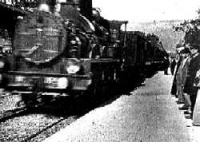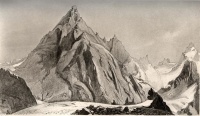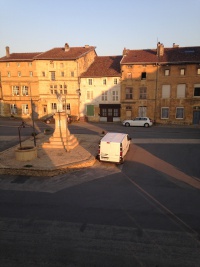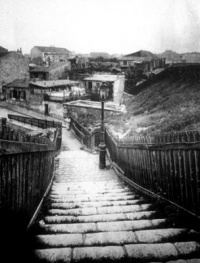France
From The Art and Popular Culture Encyclopedia



|
Related e |
|
Featured: |
France is a European country bordered by Belgium, Luxembourg, Germany, Switzerland, Italy, Monaco, Andorra, and Spain.
France is the most visited country in the world, receiving over 75 million foreign tourists (including business visitors) annually.
Contents |
Etymology
Originally applied to the whole Frankish Empire, the name "France" comes from the Latin Francia, or "country of the Franks". Modern France is still named today Francia in Italian and Spanish, Frankreich in German and Frankrijk in Dutch, all of which have the same historical meaning.
There are various theories as to the origin of the name Frank. Following the precedents of Edward Gibbon and Jacob Grimm, the name of the Franks has been linked with the word frank (free) in English. It has been suggested that the meaning of "free" was adopted because, after the conquest of Gaul, only Franks were free of taxation. Another theory is that it is derived from the Proto-Germanic word frankon, which translates as javelin or lance as the throwing axe of the Franks was known as a francisca. However, it has been determined that these weapons were named because of their use by the Franks, not the other way around.
The name of the Franks itself is also said to come "the free men", based on the fact that the word frank meant "free" in the ancient Germanic languages. However, rather than the ethnic name of the Franks coming from the word frank ("free"), it is more probable that the word frank ("free") comes from the ethnic name of the Franks, the connection being that only the Franks, as the conquering class, had the status of freemen.
Culture
Literature
The earliest French literature dates from the Middle Ages when the area that is modern France did not have a single, uniform language. There were several languages and dialects and each writer used his own spelling and grammar. The author of many French mediaeval texts is unknown, for example Tristan and Iseult and Lancelot and the Holy Grail. Much mediaeval French poetry and literature was inspired by the legends of the Matter of France, such as the The Song of Roland and the various Chansons de geste. The “Roman de Renart”, written in 1175 by Perrout de Saint Cloude tells the story of the mediaeval character Reynard ('the Fox') and is another example of early French writing. The names of some authors from this period are known, for example Chrétien de Troyes and Duke William IX of Aquitaine, who wrote in Occitan.
An important 16th century writer was François Rabelais who influenced modern French vocabulary and metaphor. During the 17th century Pierre Corneille, Jean Racine and Molière's plays, Blaise Pascal and René Descartes's moral and philosophical books deeply influenced the aristocracy leaving an important heritage for the authors of the following decades. Jean de La Fontaine was an important poet from this century. French literature and poetry flourished in the 18th and 19th centuries. The 18th century saw the works of writers, essayists and moralists such as Voltaire, Denis Diderot and Jean-Jacques Rousseau.
Charles Perrault was a prolific writer of children's stories such as: “Puss in Boots”, “Cinderella”, “Sleeping Beauty” and “Bluebeard”.
At the turn of the 19th century symbolist poetry was an important movement in French literature, with poets such as Charles Baudelaire, Paul Verlaine and Stéphane Mallarmé. The 19th century saw the writing of many French novels of world renown with Victor Hugo (Les Misérables), Alexandre Dumas (The Three Musketeers and The Count of Monte-Cristo), and Jules Verne (Twenty Thousand Leagues Under the Sea) among the most well-known in France and beyond. Other 19th century fiction writers include Emile Zola, Guy de Maupassant, Théophile Gautier and Stendhal.
The Prix Goncourt is a French literary prize first awarded in 1903. Important writers of the 20th century include Marcel Proust, Louis-Ferdinand Céline, Albert Camus, and Jean-Paul Sartre. Antoine de Saint Exupéry wrote Little Prince which has remained popular for decades with children and adults around the world.
Art
The origins of French art were very much influenced by Flemish art and by Italian art at the time of the Renaissance. Jean Fouquet, the most famous medieval French painter, is said to have been the first to travel to Italy and experience the Early Renaissance at first hand. The Renaissance painting School of Fontainebleau was directly inspired by Italian painters such as Primaticcio and Rosso Fiorentino, who both worked in France. Two of the most famous French artists of the time of Baroque era, Nicolas Poussin and Claude Lorrain, lived in Italy.
The 17th century was the period when French painting became prominent and individualized itself through classicism. Louis XIV's prime minister Jean-Baptiste Colbert founded in 1648 the Royal Academy of Painting and Sculpture to protect these artists, and in 1666 he created the still-active French Academy in Rome to have direct relations with Italian artists.
French artists developed the rococo style in the 18th century, as a more intimate imitation of old baroque style, the works of the court-endorsed artists Antoine Watteau, François Boucher and Jean-Honoré Fragonard being the most representative in the country. The French Revolution brought great changes, as Napoleon favoured artists of neoclassic style such as Jacques-Louis David and the highly influential Académie des Beaux-Arts defined the style known as Academism. At this time France had become a centre of artistic creation, the first half of the 19th century being dominated by two successive movements, at first Romanticism with Théodore Géricault and Eugène Delacroix, and Realism with Camille Corot, Gustave Courbet and Jean-François Millet, a style that eventually evolved into Naturalism.
In the second part of the 19th century, France's influence over painting became even more important, with the development of new styles of painting such as Impressionism and Symbolism. The most famous impressionist painters of the period were Camille Pissarro, Édouard Manet, Edgar Degas, Claude Monet and Auguste Renoir. The second generation of impressionist-style painters, Paul Cézanne, Paul Gauguin, Toulouse-Lautrec and Georges Seurat, were also at the avant-garde of artistic evolutions, as well as the fauvist artists Henri Matisse, André Derain and Maurice de Vlaminck.
At the beginning of 20th century, Cubism was developed by Georges Braque and the Spanish painter Pablo Picasso, living in Paris. Other foreign artists also settled and worked in or near Paris, such as Vincent van Gogh, Marc Chagall, Amedeo Modigliani and Wassily Kandinsky.
Many museums in France are entirely or partly devoted to sculptures and painting works. A huge collection of old masterpieces created before or during the 18th century are displayed in the state-owned Musée du Louvre, such as Mona Lisa, also known as La Joconde. While the Louvre Palace has been for a long time a museum, the Musée d'Orsay was inaugurated in 1986 in the old railway station Gare d'Orsay, in a major reorganization of national art collections, to gather French paintings from the second part of the 19th century (mainly Impressionism and Fauvism movements).
Modern works are presented in the Musée National d'Art Moderne, which moved in 1976 to the Centre Georges Pompidou. These three state-owned museums welcome close to 17 million people a year. Other national museums hosting paintings include the Grand Palais (1.3 million visitors in 2008), but there are also many museums owned by cities, the most visited being the Musée d'Art Moderne de la Ville de Paris (0.8 million entries in 2008), which hosts contemporary works.
Outside Paris, all the large cities have a Museum of Fine Arts with a section dedicated to European and French painting. Some of the finest collections are in Lyon, Lille, Rouen, Dijon, Rennes and Grenoble.
Philosophy
Medieval philosophy was dominated by Scholasticism until the emergence of Humanism in the Renaissance. Modern philosophy began in France in the 17th century with the philosophy of René Descartes, Blaise Pascal, and Nicolas Malebranche. Descartes revitalised Western philosophy, which had been declined after the Greek and Roman eras. His Meditations on First Philosophy changed the primary object of philosophical thought and raised some of the most fundamental problems for foreigners such as Spinoza, Leibniz, Hume, Berkeley, and Kant.
During the 18th century, French philosophers produced one of the most important works of the Age of Enlightenment. In The Spirit of the Laws, Baron de Montesquieu theorized the principle of separation of powers, which has been implemented in all liberal democracies since it was first applied in the United States. In The Social Contract, Jean-Jacques Rousseau openly criticized the European divine right monarchies and strongly affirmed the principle of the sovereignty of the people. Voltaire came to embody the Enlightenment with his defence of civil liberties, such as the right to a free trial and freedom of religion.
19th-century French thought was targeted at responding to the social malaise following the French Revolution. Rationalist philosophers such as Victor Cousin and Auguste Comte, who called for a new social doctrine, were opposed by reactionnary thinkers such as Joseph de Maistre, Louis de Bonald and Lamennais, who blamed the rationalist rejection of traditional order. De Maistre is considered, together with the Englishman Edmund Burke, one of the founders of European conservatism, while Comte is regarded as the founder of positivism and sociology.
In the early 20th century, French spiritualist thinkers such as Maine de Biran and Henri Bergson influenced Anglo-Saxon thought, including the Americans Charles Sanders Peirce and William James, and the Englishman Alfred North Whitehead. In the late 20th century, partly influenced by German phenomenology and existentialism, postmodern philosophy began in France, with notable post-structuralist thinkers including Jean-François Lyotard, Jean Baudrillard, Jacques Derrida, Jacques Lacan, Michel Foucault and Gilles Deleuze.
See also
- French art
- History of France
- French censorship
- Venus in France
- French literature
- French philosophy
- Francophilia
- Stereotypes of French people
- Problem in defining "French" culture
- List of monumental trees in France






